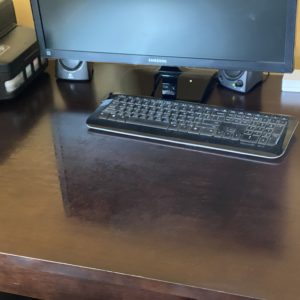We made the mistake of putting a clear plastic keyboard pad on the desk. It’s been maybe 2 years. Anyway, you can see the result. When looking at it against the sunlight it really “stands out”. When looking the other direction you really don’t notice it.
Anyway, what do you suggest? I’m not a woodworker but can do some basic stuff with confidence. If the recommendation is “take it to a professional to re-finish”, what would be a ballpark cost I should expect? The desk top is about 66″ x 32″.
Thanks
Eric
















Replies
A couple questions. What kind of wood is it? Is it solid wood or a veneer? Can you find the start button on sandpaper?
Do you by chance know what type of finish it is? Is a commercial finish or something build by a local craftsman? By the gloss I would think some type of lacquer or varnish.
In situations like this it's important to start conservatively, its easy to get more aggressive but impossible to undo something if the damage has been done. My first step would be to start with a very mild abrasive like 0000 steel wood or a white scotchbrite pad and lightly abrade a small area checking frequently to measure progress. You might also try carefully rubbing some lacquer thinner on a small inconspicuous area, although on a desk top that would be hard to find, with a slightly damp, not wet rag, if the finish is lacquer it may reconstitute itself, but it would still need to be lightly sanded and buffed to bring back the shine. You can do this with linseed oil and pumice, the old school way or use a commercial buffing compound either way the key is slow and easy checking frequently for signs you may be sanding through the finish.
May I add that it's very easy using hand rubbing methods to apply too much localized pressure causing one to rub through the finish. To avoid this, rubbing should be done using a damp rag on a sponge-backed block, just like when sanding.
The damage may only be surface deep and you may be able to simply buff it out with a commercial auto body buffing compound. Start with a very fine compound. Long strokes, back and forth, with the grain, on the entire top. Mist with a little water from a spray bottle helps. Back and forth 2 or 3 times. Wipe it off and see how it looks.--That would be my first approach. It will bring out more shine than originally there, but the damage will hopefully disappear.
Perhaps the legs of the desk would be suitable for testing if it's a lacquer finish. If so, spraying would re-constitute the finish as mentioned. But that brings its own problems. --Namely surface blemishes (fisheyes, orange peel, etc) when re-sprayed due to the contamination from cleaning products and furniture polishes. Professionals have access to lacquer additives to overcome (lessen the possiblity of) these, but still the surface would need to be cleaned well.
I highly doubt that it would need to be re-finished in the traditional sense.
I'm just giving you my best guess here. I wouldn't think more than $200 (and probably less) to buff it out and assuming it can't be completely removed, then to clean and respray it.
Thanks! Here is a picture from under the desk looking up to the top. Appears that top is definitely not solid? It was purchased from Thomasville, a large higher-end furniture chain that went out of business a few years ago.
Looks like MDF. Go as gentle as you can, especially with liquids. MDF is notorious for swelling when it gets wet.
This forum post is now archived. Commenting has been disabled